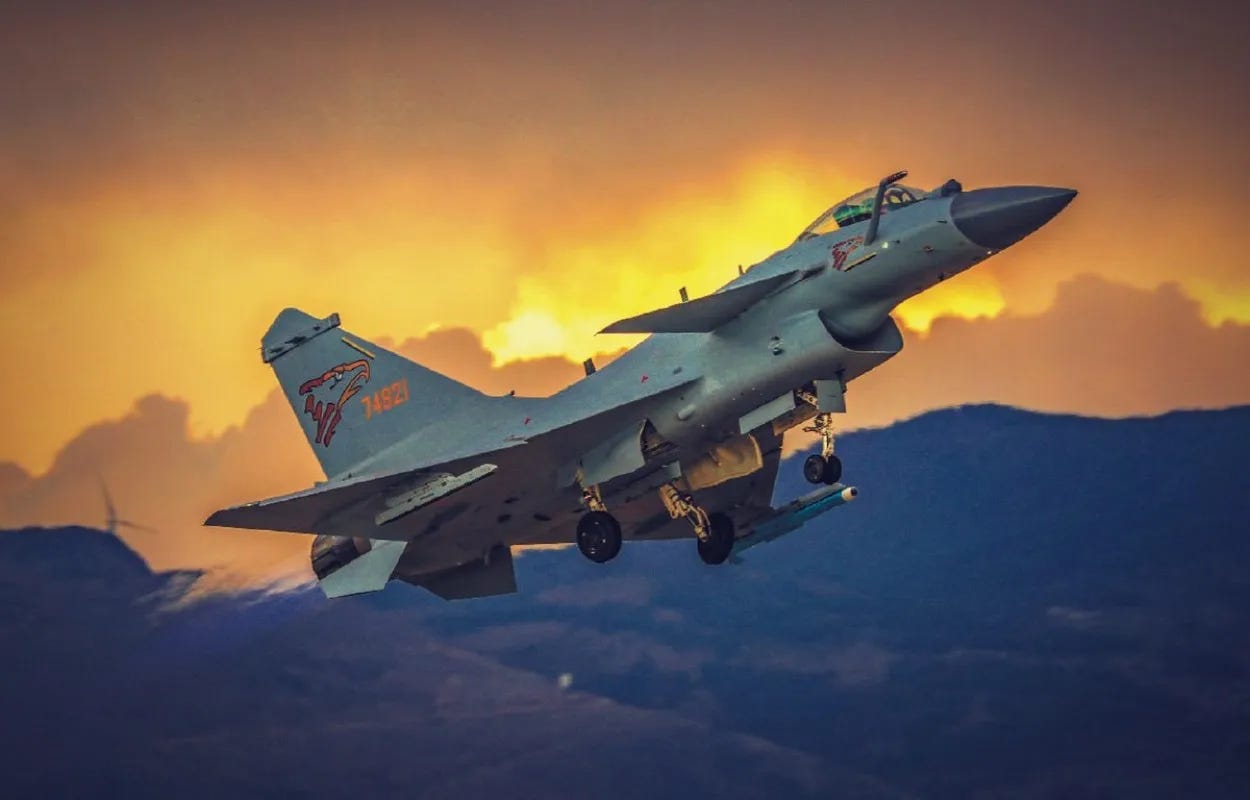How a Single Engagement Reframed Air Superiority – Part I: A Shift is in the Air
Chinese integrated systems are a wakeup call for the global defense sector
A Chinese J-10C in flight (sort of looks like Fujian province). Image source
On May 7, the Pakistan Air Force (PAF) claimed it shot down five Indian fighter jets during a dogfight over Pakistani airspace that lasted just over an hour. The downed fighters reportedly included three French-made Rafales—India’s most advanced jets—as well as two Russian-made aircraft: a MiG-29 and a Su-30MKI. According to PAF officials, Chinese-made Chengdu J-10C fighters, equipped with PL-15 long-range missiles and supported by airborne early warning (AEW) and electronic warfare systems, were used in the operation. These integrated systems likely played a critical role, enabling the PAF to conduct more seamless target acquisition, coordinated engagement (possibly with Chinese-supplied ground-based systems), and real-time data fusion—capabilities India’s diffuse systems apparently lacked by comparison. While New Delhi has not officially confirmed the losses, visual evidence reviewed by The Washington Post appears to corroborate Islamabad’s claims.
This incident marks the first confirmed combat use of a modern Chinese fighter jet. That the J-10Cs were used—over Pakistan’s long-standing American-made F-16 program—to down multiple high-end Western aircraft is geopolitically significant, especially considering these Chinese systems had never been tested in real combat. Given India’s numerical and technological advantage in air power, the incident has shocked observers in New Delhi and sent ripples through global defense circles, enhancing calls for adopting more integrated systems.
An infographic detailing the comparative specifications of the Chengdu J-10C and the Dassault Rafale. Image source
Simulated Timeline of Events
This reconstruction was generated using AI and curated by the me. It is based on known aircraft capabilities, typical engagement pacing, and strategic assumptions from regional analysts.
07:40 AM – Indian Rafales scramble
Indian Air Force jets begin patrol operations near the Line of Control (LoC).
07:58 AM – PAF J-10Cs scramble from Lahore
Armed with PL-15E missiles and supported by AEW platforms.
08:10 AM – Detection and tracking
Pakistani radar and electronic warfare systems detect Indian formations.
08:17 AM – First engagement
J-10Cs fire from distance. Two Rafales and one MiG-29 are reportedly hit.
08:22 AM – Visual confirmation
Analysts and OSINT sources suggest three Indian aircraft have been lost.
08:35 AM – Second phase begins
Two Su-30MKIs engage. Pakistan maintains electronic superiority.
08:41 AM – Fifth jet downed
A Su-30MKI is reportedly hit. Remaining Indian fighters withdraw.
08:50 AM – PAF returns to base
Pakistani fighters land without confirmed losses.
09:10 AM – Pakistan issues public statement
Islamabad credits Chinese systems for the success.
11:30 AM – India responds
The Indian Ministry of Defence denies losses and requests third-party verification.
Why This Matters
If confirmed, this incident marks a tactical and symbolic milestone. Real-time integration of air assets—radar, jammers, missiles, and fighters—enabled a mid-tier air force to defeat a larger and better-equipped adversary. Analysts in Taiwan, Japan, and across NATO are now reevaluating legacy force structures that lack full-spectrum system interoperability. In short, the future of aerial warfare may not be defined by aircraft superiority alone—but by how effectively systems across air, space, and ground are networked.
In this three-part series, I’ll explore:
The history and evolution of the Chengdu J-10 and China’s broader integration strategy, and its extensive use of technology transfers and dual-use technologies;
The global response, including new demands for integrated air defense systems;
The shifting landscape of arms procurement, strategic partnerships, and military doctrine.
This article is free, but the next ones aren’t. If you are interested in this topic and others I cover, consider becoming a paid subscriber. It helps me out a lot.
Next up: Part II: Chinese Military Modernization, the Development of the J10, and the Pakistani Pivot





Interesting, and I'm looking forward to the remaining parts. Thanks Adam!
Bit scary that China has such a fighter. Wonder what other military systems they may have built over the years?